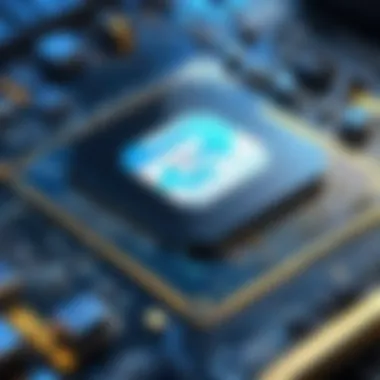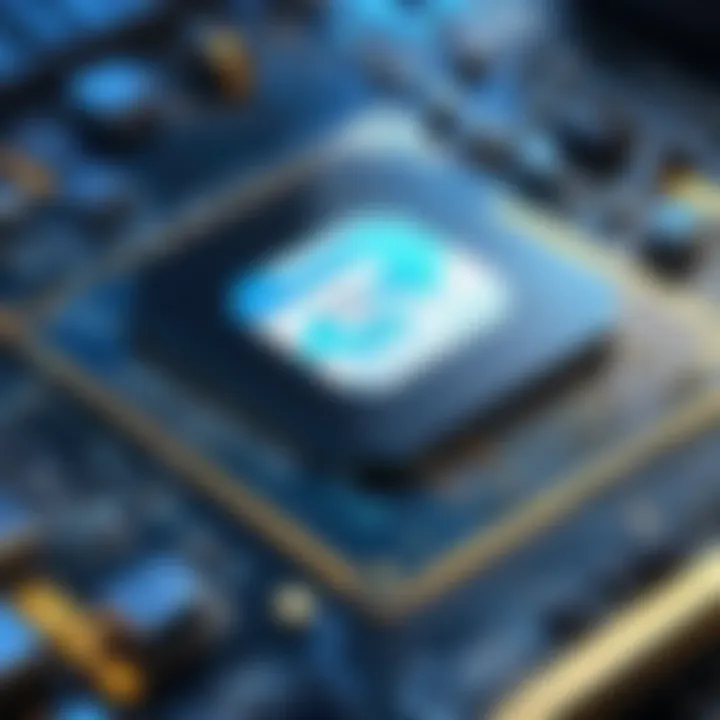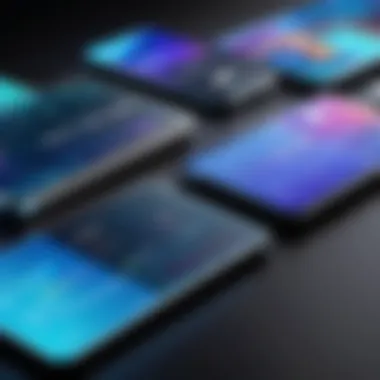Creating an NFT: A Comprehensive Guide to Success


Intro
In recent years, Non-Fungible Tokens (NFTs) have emerged as a prominent element within the digital economy. As a new form of digital assets, NFTs represent ownership through the blockchain, allowing for unique digital items to be bought, sold, and traded. This guide aims to demystify the process of creating an NFT, ensuring aspiring creators understand the necessary components involved.
Art, music, collectibles, and more can all be transformed into NFTs, making this technology particularly appealing to artists and creators seeking new revenue streams. Understanding how to create an NFT involves not only technical knowledge but also insight into the artistic and strategic facets of this burgeoning space.
The exploration includes an overview of blockchain technologies, various platforms available for minting, and the legal considerations surrounding digital ownership. This comprehensive approach equips creators with the knowledge to navigate the complexities of the NFT ecosystem effectively. It is critical to grasp the significance behind non-fungibility and how it differentiates NFTs from other digital tokens.
By seeking clarity and uncovering vital information in the realm of NFTs, readers can enhance their capabilities and potentially benefit from a thriving market.
Prologue to NFTs
Non-Fungible Tokens, or NFTs, have revolutionized the way we perceive digital ownership. They represent unique digital assets verified using blockchain technology. Explaining NFTs entails covering their definitions, historical evolution, and their impact on the digital economy. Understanding these components is crucial for anyone interested in creating NFTs.
Definition of NFTs
NFTs are digital assets that represent ownership or proof of authenticity for a unique item. Unlike cryptocurrencies such as Bitcoin, which are fungible and can be exchanged one-for-one, NFTs hold distinct properties. Each NFT is unique and cannot be exchanged directly for another on a one-to-one basis. They typically include digital art, music, collectibles, gaming assets, and even virtual real estate.
The uniqueness of these tokens stems from the information stored on the blockchain. This information includes the token's origin, transaction history, and the details about the underlying asset. When an NFT is purchased, the buyer receives a digital certificate that represents their ownership.
Historical context and evolution
The concept of NFTs originated around 2012 with the introduction of colored coins on the Bitcoin blockchain. However, they gained considerable traction with the launch of the Ethereum blockchain in 2015. Ethereum allowed developers to create smart contracts, enabling the issuance of unique digital tokens.
In 2017, the NFT market saw a milestone with the release of projects like CryptoPunks and CryptoKitties. These became the early examples of successful NFT campaigns, bringing significant public attention. Since then, NFTs have evolved dramatically, finding applications in art, gaming, and even branding.
Importance in the digital economy
The significance of NFTs in the digital economy cannot be overstated. They have opened new avenues for creators to monetize digital content. Streets flooded with traditional publishers and galleries are giving way to decentralized platforms, where original artists can sell their work directly to consumers. This model enhances transparency and reduces reliance on intermediaries.
Furthermore, NFTs have allowed for real and measurable economic activity within virtual environments. Virtual goods, once undervalued, are gaining recognition as assets. With the increasing interest in the metaverse, the relevance of NFTs in commerce will only continue to grow.
"NFTs are fundamentally altering the digital economy by creating verifiable ownership and scarcity for digital assets."
In summary, the introduction to NFTs provides a foundational understanding of their role in the modern economy. Defining what NFTs are, tracing their history, and recognizing their economic importance are vital for anyone interested in venturing into the NFT landscape.
Understanding Blockchain Technology
Blockchain technology serves as the backbone of NFTs, providing a secure, decentralized, and tamper-proof platform for digital assets. Understanding this technology is essential for anyone looking to create and manage NFTs. In this section, we will delve into the basics of blockchain, how it functions, and its pivotal role in supporting the unique characteristics of NFTs.
Basics of blockchain
At its core, a blockchain is a distributed ledger that records transactions across numerous computers. This ensures that the data is not housed at a single location, making it highly secure against interference and fraud. Each block in the chain contains transaction data, and they are linked together in chronological order.
Key features of blockchain include:
- Decentralization: Unlike traditional databases, a blockchain operates without a central authority.
- Transparency: Every transaction on the blockchain is visible to all participants, fostering trust.
- Immutability: Once a block is added to the chain, it cannot be altered, ensuring data integrity.
These attributes provide the necessary framework for creating NFTs, which rely on this secure and transparent environment.
How blockchain supports NFTs
NFTs, or Non-Fungible Tokens, are unique digital assets that represent ownership of specific items or content, such as art, music, and virtual real estate. Blockchain technology plays a fundamental role in the creation and management of NFTs in several ways:
- Unique Provenance: Each NFT is registered on the blockchain with a unique identifier, ensuring that it cannot be replicated.
- Ownership Transparency: The ownership history of an NFT is publicly available, allowing creators and buyers to verify authenticity.
- Smart Contracts: These self-executing contracts with the agreement terms directly written into code facilitate automatic transactions when specific conditions are met. This ensures that creators receive royalties from secondary sales without intermediaries.
"Understanding blockchain is crucial for realizing the potential of NFTs. It empowers creators and buyers alike to engage in a secure and verifiable digital ecosystem."


The intersection of blockchain technology and NFTs illustrates a transformative landscape in digital ownership, offering unprecedented opportunities for creators and collectors. As you consider entering this space, a solid grasp of blockchain concepts will enhance your ability to innovate and navigate the complexities of NFT creation.
Choosing the Right NFT Platform
Choosing the right NFT platform is a pivotal step in the process of creating and trading Non-Fungible Tokens. A suitable platform not only provides the technical infrastructure to mint and sell NFTs but also significantly affects visibility and interaction with potential buyers. This importance lies in the variety of platforms available, each offering unique features, tools, and audiences. Selecting the right one can enhance your success and streamline your journey in the NFT space.
Several considerations come into play when examining NFT platforms. First, the community associated with the platform plays a crucial role. Engaging with like-minded collectors and artists allows for networking opportunities and can lead to a higher likelihood of selling your creation. Second, transaction costs, often referred to as gas fees, can vary greatly. Higher fees can eat into your profits, so it is advisable to analyze these expenses before committing to a platform. Furthermore, look into the user interface of the platforms. This can greatly influence the ease with which you can navigate the site, create your NFTs, and interact with buyers. A complicated interface may deter potential buyers, so finding a user-friendly platform is essential.
Lastly, consider the platform's market reach. Some platforms are more popular for specific types of NFTs, such as digital art or music. Choosing a marketplace that aligns with your niche will enhance the chances of reaching your target audience effectively.
"Selecting the right NFT platform can determine your visibility and interaction with potential buyers."
Popular NFT marketplaces
When delving into the NFT marketplace landscape, several platforms stand out, each with distinct offerings and community engagement. OpenSea is among the largest and most well-known NFT marketplaces, allowing users to buy, sell, and trade a variety of digital assets. It supports numerous types of NFTs, making it a versatile choice for creators. Rarible distinguishes itself through its decentralized governance, enabling users to participate in decisions impacting the platform.
Foundation is another marketplace that focuses on fostering a community of artists and collectors, featuring a robust curation process. This can be appealing for those looking to sell high-quality digital art, as its exclusivity often attracts serious collectors. Other notable platforms include Mintable, which provides an intuitive minting process for creators, and Zora, which emphasizes decentralization and control over the pricing of assets.
Factors to consider when selecting a platform
Several elements must be considered when choosing an NFT platform:
- Fees: Check the listing and transaction fees. Lower fees can increase your profit margin.
- Ease of Use: A user-friendly interface reduces the technical learning curve and enhances the experience.
- Community and Audience: Look for a platform that attracts your target audience to improve your potential for sales.
- Support for Various Assets: Ensure the platform supports the type of NFTs you create, be it art, music, or gaming items.
- Security Measures: Research the security features to safeguard your assets and transactions.
By analyzing these factors carefully, you can select a platform that aligns with your goals as an NFT creator.
Creating Digital Art for NFTs
Creating digital art is a crucial component of the NFT ecosystem. The uniqueness and creativity of digital artworks largely define the value of an NFT. In a world where digital assets are abundant, having the ability to create distinct and engaging digital art can set an NFT apart. As NFTs gain more traction in the market, artists are beginning to explore novel ways to express their creativity while leveraging blockchain technology.
The benefits of creating digital art for NFTs include not only the potential for financial gain but also the chance to reach a global audience. Artists can showcase their unique styles and concepts, breaking away from traditional art market constraints. Moreover, NFTs facilitate a new form of ownership that is transparent and immutable, offering artists a way to track the provenance of their work and ensure they receive royalties on future sales.
However, there are crucial considerations that artists need to take into account. This includes understanding the types of digital art that work best as NFTs, the tools available for artists, and the legal implications surrounding digital ownership.
Types of Digital Art Suitable for NFTs
There are various types of digital art that lend themselves well to being minted as NFTs. Some popular categories include:
- Digital illustrations: These can range from hand-drawn pieces to intricate designs created with software.
- 3D models: Artists can create 3D objects or characters, which can also be animated to add interactivity.
- Photography: High-quality digital photographs can find a place in the NFT market, often attracting collectors who value visual storytelling.
- Video art: Short films or video clips can be compelling NFTs when they include artistic concepts.
- Music and audio files: Musicians and sound artists can present their compositions as NFTs, providing a new way for them to monetize their work.
Each type has its unique appeal and applications, and artists should consider their strengths and preferences when choosing which medium to explore.
Tools and Software for Artists
To create digital art, artists have access to a plethora of tools and software. Some widely used programs include:
- Adobe Photoshop: This software is key for painting and photo manipulation.
- Adobe Illustrator: Ideal for creating vector graphics that maintain quality at any size.
- Procreate: A favorite among illustrators for its user-friendly interface, particularly on iPads.
- Blender: A powerful open-source 3D modeling tool used for creating 3D assets.
- Clip Studio Paint: Popular among comic and manga artists for its drawing capabilities.
These tools enable artists to experiment with styles and techniques, pushing their creativity to new limits.
Copyright and Ownership Issues
Copyright and ownership are significant factors to consider in the NFT space. It is vital for artists to establish their rights over the digital creations they produce. Here are important points regarding these issues:
- Intellectual property rights: Artists should ensure they hold copyright over the art they create. Without proper rights, an artist may face legal challenges.
- Licensing agreements: Consider how you want to license your NFTs. Different license types dictate how others can use, share, or exploit your art.
- Transfer of ownership: When an NFT is sold, the ownership of the digital art changes hands. Artists must understand what rights are transferred to the buyer and what remains with them.
"Seeking legal advice can help navigate copyright and ownership issues effectively."


Understanding these complexities can protect artists from potential disputes, allowing them to focus on their creativity while maximizing their engagement in the NFT marketplace.
Minting Process of NFTs
The minting process of NFTs is a critical part of their creation and functionality. To mint an NFT means to convert a digital file into a crypto asset on a blockchain. This process not only establishes the token’s existence but also connects it to its creator through ownership records stored on the blockchain. Understanding this step is vital for anyone looking to enter the NFT market, as it involves certain technical and financial considerations that may impact the overall success of the created NFT.
Through minting, creators can ensure their work is unique and traceable, an essential factor in the realm of digital art and collectibles. In addition, minting plays a significant role in establishing the NFT's authenticity and provenance, which are crucial attributes in the eyes of potential buyers. Furthermore, the minting process defines the NFT's capabilities, such as any royalties or restrictions on resale. Thus, grasping the nuances of NFT minting is fundamental for both creators and collectors alike.
Steps to mint an NFT
Minting an NFT involves several specific steps, each crucial for ensuring the token functions correctly. Below, we outline the essential procedures:
- Select a Digital Asset: Choose the digital file you wish to mint, whether it's an artwork, music, video, or any other digital file.
- Choose a Blockchain: Pick the blockchain on which to mint your NFT. Ethereum is the most popular, but other options include Binance Smart Chain, Flow, and Tezos.
- Create a Digital Wallet: Establish a cryptocurrency wallet that supports NFTs and the chosen blockchain. Examples include MetaMask and Trust Wallet. This will be important to store your NFTs and the cryptocurrencies needed for gas fees.
- Connect to an NFT Marketplace: Select a platform to mint your NFT. Platforms like OpenSea, Rarible, or Mintable offer user-friendly interfaces for creating your tokens.
- Upload Your Digital File: Follow the marketplace’s instructions to upload the digital asset.
- Provide Metadata: Fill in the necessary details, including title, description, and any attributes that explain the uniqueness of your NFT.
- Set a Price: Decide whether to sell your NFT at a fixed price, through an auction, or not sell it at all.
- Mint the NFT: Complete the minting process, which usually involves confirming the transaction through your digital wallet. This step will invoke gas fees, which vary based on network activity.
- Confirm the Process: After minting, your NFT will appear in your wallet and are visible on the marketplace.
Gas fees and transaction costs
Gas fees are transaction costs incurred when minting an NFT, which is a common aspect of blockchain transactions. These fees can fluctuate based on network usage and specific blockchain protocols. In essence, gas fees are what facilitate the processing of your transaction by miners or validators who confirm the transaction and add it to the blockchain.
- Factors Influencing Gas Fees:
- Network congestion: High demand on the network can significantly raise costs.
- Complexity of the transaction: More complex transactions may involve higher fees.
It's essential to check gas prices regularly and plan your minting timing accordingly. Here are a few tips to reduce gas fees:
- Mint during off-peak times: Try to mint your NFT during hours when network traffic is lower.
- Choose a less congested blockchain: Some blockchains have lower gas fees compared to others.
Overall, understanding gas fees is crucial for budgeting the total cost of minting an NFT, ensuring you do not face unexpected expenses that could deter potential profits.
"Minting an NFT is not just about creating a token; it is about embedding your work in a new economic model."
By comprehending the steps to mint an NFT and the implications of gas fees, creators position themselves for success in the burgeoning NFT marketplace.
Marketing Your NFT
Marketing is crucial in the world of NFTs. Even a well-crafted digital asset needs visibility to attract buyers. The uniqueness of NFTs offers immense opportunities, but without effective marketing, they risk being lost in a sea of content. A focused strategy helps to differentiate an NFT from countless others and establishes its value in the marketplace. This section will explore strategies to reach potential buyers and how to build a community around your NFT.
Strategies for reaching potential buyers
To effectively market your NFT, consider the following strategies:
- Social Media Advertising: Platforms like Twitter and Instagram are essential for reaching a broad audience. Post regularly about your NFT's features, concepts, and value, and use appropriate hashtags such as #NFT, #DigitalArt, and #CryptoArt.
- Collaborations with Influencers: Partnering with NFT influencers can amplify your reach. Their established audience trusts their opinions, which can lead to increased visibility and sales for your NFT.
- Engage in NFT Communities: Join platforms like Discord and Reddit that cater to NFT enthusiasts. Participating in discussions and sharing your insights will help establish your credibility while introducing your work to potential buyers.
- Create Compelling Content: Use storytelling to connect emotionally. Share the inspiration behind your artwork. High-quality images and videos can also make a significant impact in showcasing the uniqueness of your NFT.
- Utilize Email Marketing: Build an email list of interested parties. Send newsletters that include updates, drops, or exclusive offers related to your NFTs. This direct form of communication fosters interest and excitement.
Keep in mind, understanding your target audience is imperative. Knowing what excites them and what they value in an NFT can significantly shape your marketing efforts.
Building a community around your NFT
Building a community is a powerful way to ensure ongoing engagement with your NFT. Here are some effective methods:
- Create a Dedicated Website: This serves as a hub for information about your NFTs. Include a blog with updates, highlights on upcoming sales, or details about the creative process. A website fosters loyalty and provides a central point for followers.
- Host Virtual Events: Organize online meetups or exhibitions. These events can allow potential buyers to interact with you directly, ask questions, and experience your art first-hand. The sense of access improves the community feeling.
- Offer Exclusive Experiences: Consider providing rewards or exclusive perks for community members. This could range from early access to new NFTs, exclusive content, or even one-on-one chats with you as the creator.
- Engage Regularly: Use social media or forums to keep the conversation going. Responding to comments or messages shows that you value your community. Regular updates and interactions build relationships.
"Community is key to sustainability in the NFT market. It fosters loyalty and encourages word-of-mouth promotion."
- Use Feedback: Listen to your community's thoughts and incorporate their feedback into your future creations. This involvement can generate more interest and loyalty, leading to a thriving ecosystem around your NFT.
Legal Considerations in the NFT Space
Understanding the legal landscape surrounding Non-Fungible Tokens (NFTs) is essential for creators and collectors alike. The rise of NFTs has raised numerous legal questions and challenges. Navigating through these complexities can be the difference between a successful venture and potential legal pitfalls. Thus, grasping legal considerations is indispensable for anyone interested in creating or trading NFTs.


One crucial aspect of legal considerations involves intellectual property rights. This area encompasses the rights creators hold over their digital works. Each NFT typically represents ownership of a specific digital asset. However, owning an NFT does not automatically transfer copyright or other related rights. Creators must clarify what rights they intend to transfer with the sale of their NFTs. For example, they can choose to sell the work while retaining reproduction rights, enabling them to create prints or merchandise based on their work.
Understanding intellectual property rights
Intellectual property (IP) refers broadly to the legal rights that protect creations of the mind, including inventions, literary and artistic works, and designs. When creating NFTs, it is crucial for artists to understand their own IP rights as well as those of others. If an artist mints an NFT without owning the original content or having proper authorization, they risk infringing on someone else's copyright.
To avoid issues, it's prudent to:
- Confirm ownership of all works before minting.
- Consult legal advice if uncertain about rights associated with digital content.
- Create clear terms about what is included with the NFT sale.
Key points on IP:
- Ownership of an NFT does not equate to ownership of the underlying copyright.
- Licenses or agreements can clarify rights transferred with the NFT.
- Misunderstanding IP rights can lead to costly legal disputes.
Tax implications of NFT sales
Taxation in the NFT space is not straightforward, as it often varies by jurisdiction and the nature of the transaction. When dealing with cryptocurrencies and NFTs, creators and buyers should be aware of potential tax obligations.
Generally, selling NFTs can trigger capital gains taxes if the asset appreciates in value. Conversely, losses can also be deducted under certain conditions. Transactions involving cryptocurrencies used to purchase NFTs can have tax implications as well, classified as property for tax purposes.
It’s advisable to:
- Keep precise records of all NFT transactions for tax purposes.
- Understand how local regulations apply to NFT sales and purchases.
- Consider consulting a tax advisor to navigate complexities in tax obligations related to digital assets.
"Navigating tax implications is crucial for an NFT creator; failing to understand can lead to unexpected liabilities."
Future Trends in NFTs
The landscape of Non-Fungible Tokens (NFTs) is rapidly evolving, influenced by technological advancements and changing market dynamics. Understanding future trends in NFTs is crucial for anyone interested in this space. These trends not only shape the creation and sale of NFTs but also provide insight into how they can be integrated into various sectors. Keeping an eye on these developments can create opportunities for artists, collectors, and investors alike.
Emerging technologies influencing NFTs
Several emerging technologies are setting the pace for the next phase of NFTs. These include augmented reality (AR), virtual reality (VR), and artificial intelligence (AI).
- Augmented Reality (AR): AR is beginning to reshape how NFTs are perceived. Artists can create dynamic pieces that allow users to engage with the art in new ways using AR technology. Imagine holding your smartphone up to a piece of digital art and seeing animated elements come to life. This added interactivity can enhance the value of NFTs.
- Virtual Reality (VR): With VR headsets becoming more accessible, the creation of virtual galleries showcases NFTs in immersive environments. This allows collectors to experience art in a three-dimensional space, effectively transforming traditional viewing methods.
- Artificial Intelligence (AI): AI-generated art is quickly gaining popularity. Many artists use AI algorithms to create unique pieces that can then be minted as NFTs. This raises interesting discussions about authorship and originality in the digital art space.
Furthermore, blockchain interoperability is progressing. As multiple blockchains evolve, NFTs can be transferred across different platforms seamlessly. This not only boosts liquidity but also widens the market reach for creators.
Potential impact on various industries
NFTs are not confined to just digital art or collectibles. Their potential impact spans various industries. Here are a few noteworthy examples:
- Entertainment: The music industry is already using NFTs for album releases. Musicians can sell exclusive rights to songs or even create unique experiences for fans. This can fundamentally change revenue models in an industry heavily reliant on streaming.
- Gaming: Gaming is perhaps the most disrupted sector due to NFTs. Players can own in-game assets as NFTs, providing real-world value for their digital possessions. This creates a new economy where players can trade, sell, or collect in-game items outside traditional platforms.
- Fashion: Luxury brands are exploring NFTs to authenticate and track ownership of high-end goods. Digital fashion items sold as NFTs could also lead to new revenue streams and marketing approaches in the industry.
- Real Estate: Property ownership and transactions can be simplified using NFTs. They can represent ownership rights, making transfers easier and more secure. This is particularly relevant in a world where transparency is crucial.
In summary, the future of NFTs looks bright and full of potential. Emerging technologies will continue to enhance the user experience, while various industries will find innovative applications for NFTs that extend beyond digital art alone.
Finale
The conclusion of this guide on creating an NFT serves as a vital component, encapsulating the entire process from conception to realization. It is essential to recognize the significance of distilling complex information into key takeaways. This aids not only in solidifying the reader's understanding but also allows for practical application of the knowledge gained throughout the article.
Summary of key points
In reviewing the intricacies involved in NFT creation, several critical points emerge:
- Understanding the fundamentals: A clear grasp of what NFTs are and the blockchain technology that enables them is paramount.
- Choosing a platform wisely: Different NFT marketplaces offer various features. Identifying which platform aligns with one’s goals is crucial for success.
- Navigating the minting process: Understanding gas fees and the technical requirements for minting ensures a smoother experience.
- Marketing strategies: Building a community around an NFT can enhance visibility and sales potential.
- Legal understanding: Comprehending intellectual property rights and tax implications protects creators from future issues.
Each of these elements contributes to a comprehensive understanding of how best to approach NFT creation.
Final thoughts on NFT creation
The journey of creating an NFT is both exciting and complex. As the landscape of digital assets continues to evolve, creators must remain adaptable. Successful NFT creation hinges not just on artistic talent, but also on strategic planning and market awareness. This guide aims to empower aspiring creators to harness the potential of NFTs effectively. As you venture into this space, remember that being well-informed is a significant advantage. Continual learning and engagement with the community will further enhance your journey, ensuring you are poised to leverage future opportunities in the digital ecosystem.
Staying ahead in the challenging NFT space requires persistence and an unyielding curiosity.
By synthesizing the knowledge from this guide, you can navigate the complexities of NFTs with confidence and creativity.



